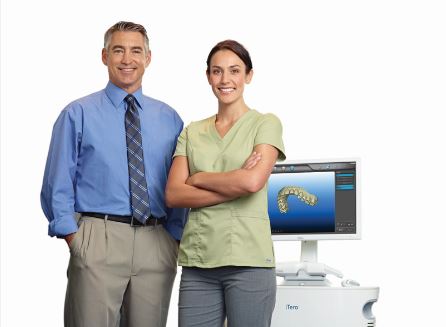Use Digital Impressions to Wow Your Patients
Ready for the speed and accuracy of digital technology in your office? DeLux makes it easy for you, with the digital, model-free workflow processes that increase patient comfort and satisfaction, as well as your own efficiency and profitability.
Applying Technology for Greater Results, Efficiency and Accuracy
Experience the many benefits this type of digitally based workflow can bring to your practice and of course, your patients!
DeLux can help you leverage the latest technological advancements in dentistry. Whether you need a single coping, long span bridgework, full crowns or custom implant abutments, we can help you to create a restoration that exhibits exceptional marginal integrity and beautiful esthetics.
What’s more, DeLux Ideal can accept your digital impression files and photos electronically via our website… simplifying and speeding the process to beginning fabrication of your restorations.
DeLux proudly works for the leading Digital Impression technology providers, including iTero, 3Shape Trios and CareStream.
Features:
- Easy hand-held scanning
- Goop-less impressions
- Ability to preview & correct images
- All-digital process
- Online case submission
Benefits:
- Higher model accuracy for better fit
- Ease of corrections
- Faster Turnaround
- Less remakes
- Competitive Advantage
Let’s take a look at just some of those benefits…
Digital Impressions Yield Dramatically Reduced Turnaround Time.
With traditional models, it normally takes two weeks for a lab to complete a crown once they receive the impression from the dentist. Working without a model can cut that time significantly.
Improved Dentist/Lab Communications
Sending a digital scan to the lab allows the dentist and technician to communicate more directly and promptly about their case. If there are any issues with the scan, those issues can be addressed right away—rather than a few days later.
Digital Impressions Yield a More Accurate Fit & Less Remakes
Using digital impressions, there’s no worry about distortion or margin inaccuracy issues as with traditional impressions. Any problems with the impression, the doctor can be seen right away and necessary adjustments can be made before sending the scan to the lab.
Patients are More Comfortable with Digital Impressions
Completely eliminating the traditional need to use “goop” in their mouth, digital impressions remove that discomfort for the patient. It also shortens prep time, shortens turnaround time and makes the patient more comfortable with the process.
Ensures You Work with a Superior, Technology-Based Lab
Running a technology-driven practice mean’s you’ll also need to work with a high-tech lab. An experienced digital lab that understands and can manage the challenges of working with the design software to establish correct design parameters and ensure you receive the accurate fitting crown you expect.
Competitive Advantage Comes with the Technology
Whey you utilize the advanced processes and provide the comfort of digital impression, your patients are going to notice. They’ll see you’ve invested in your practice and in their care, while you also save time and money.
What’s the Digital Impression Process?
Here’s a simple overview of how the digital impression workflow typically goes:
- At the Dentist’s Office -Scanning the patients’ prepped tooth area(s): Digital impressions eliminate the “tray and putty” impression, replacing it with a highly-detailed, digital scan from the handheld scanner. The dentist can now make real-time adjustments. Once approved, the scan is sent to the lab.
- At the Laboratory – Reviewing the digital model: Once received by the lab, the digital model is reviewed and any necessary adjustments are made to the virtual margin line and coping design. The model is then sent to the technology providers’ facilities for milling.
- At the Digital Impression Technology Facility – Milling the physical model: Utilizing the digital model, the provider mills a physical model and removable dies, which are sent to the lab.
- Back at the Laboratory – Creating the final restoration: Using the physical model, the lab creates the final restoration, adds aesthetic layering, and then ships the finished piece to the dental office.
- Back at the Dentist’s Office – Seating of the final restoration: The dentist then seats the restoration with little adjustment time, enabling the patient to enjoy their new smile!
Give Your Patients The Comfort They Deserve – and Give Yourself the Efficiency and Competitive Advantage YOU Deserve!


 Delight Your Patients. Trust DeLux.
Delight Your Patients. Trust DeLux. 